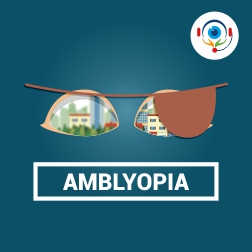Amblyopia
What is Amblyopia: Amblyopia is a form of poor vision development that occurs in children as early as 3 months of age and up to 7 years. In Amblyopia there is a reduction in the best-corrected visual acuity for which no organic cause exists. There may be deprivation of vision in any form or abnormality in the binocular interaction of the two eyes. However, this vision loss is correctable if appropriate measures are taken on time.
TYPES OF AMBLYOPIA
Strabismic
Strabismus is an eye disorder that causes double vision. The eyes are unable to look in the same direction, and appear cross-eyed. This misalignment of the eyes is the leading cause of amblyopia. The brain ignores visual input from the misaligned eye. It focuses on the input from the other eye instead, thus rendering the former eye weak.
Refractive
Refractive amblyopia occurs due to unequal refractive errors in the eyes. One of the eyes suffers from nearsightedness/farsightedness. But the other eye is perfectly functional. The amblyopia stems from this unequal refractive error in the eyes as the brain automatically tries to protect the weaker eye by relying on the healthy eye.
Deprivation
When an obstruction prevents light from reaching one of the eyes, this continued deprivation of light can lead to amblyopia. It is one of the severest forms of amblyopia and must be treated immediately. It generally happens due to pediatric eye conditions such as congenital cataracts, cornea opacities, among others.
Isometropic
It is mild to moderate form of amblyopia which occurs in bilateral high but equal refractive errors usually more in hypermetropes than myopes.
Meridional
This type of Amblyopia occurs due to uncorrected astigmatism. In this, there is decreased resolution in specific meridians due to cylindrical refractive error.
Other less common forms are organic, idiopathic ( for which no cause can be found) and hysterical.
Symptoms: While amblyopia is hard to spot without regular checkups, the most common symptoms may appear in the child’s struggle to see clearly:
There is usually decreased vision in the affected eye. The child may be having squint, cataract, corneal opacity or nystagmus.
Amblyopic patients prefer single optotypes to the letters in a row. This is known as Crowding phenomena.
There is difficulty in attaining fixation ( in which the eyes remain central when torchlight is thrown on the forehead) in the amblyopic eye.
There is improvement in vision of the amblyopic eye when neutral density filter is placed before the affected eye.
Diagnosis: Regular eye checkups for children between the ages of 3 years- 7 years can prove fruitful in the early diagnosis of amblyopia. Also the premature babies at risk of ROP should undergo early and regular check ups. Your child’s ophthalmologist will check for this condition as part of the routine checkups. Young children must undergo these checkups without fail, as they may not initially experience any issues in their vision. After which they tend to get used to the vision of the good eye and cancel out the amblyopic eye’s inputs entirely.
Prevention: Amblyopia cannot be prevented, but if detected before 7 years of age, it can be treated nearly completely. The earlier it is detected the better the chances of visual recovery. However where amblyopia occurs before 1st year of life, prognosis can be guarded.
Treatment: The treatment of amblyopia depends on its type. For instance, refractive amblyopia will first require the correction of the vision defects. This correction could be in the form of eyeglasses or contact lenses. In the case of cataracts, surgery may be recommended. Ultimately, the treatment of this eye disorder depends on the child’s diagnosis. An ophthalmologist will be able to advise you on the right course of action.
The purpose of the treatment of this eye disorder is to awaken the amblyopic eye by ensuring its usage compared to the unaffected eye. There are two basic courses of action:
- Eye patch on the better eye so that amblyopic eye is forced to work.
- Atropine eyedrops/ ointment for the good eye.
- Few drugs have also shown promising results . however, their use requires special considerations.
Takeaway: Amblyopia can be treated only if detected timely. The single most important factor which determines recovery of vision is compliance of the child and his parents. Also Amblyopia can recur if treatment is stopped midway or even after completing the treatment. However with proper occlusion therapy, vision can be recovered



